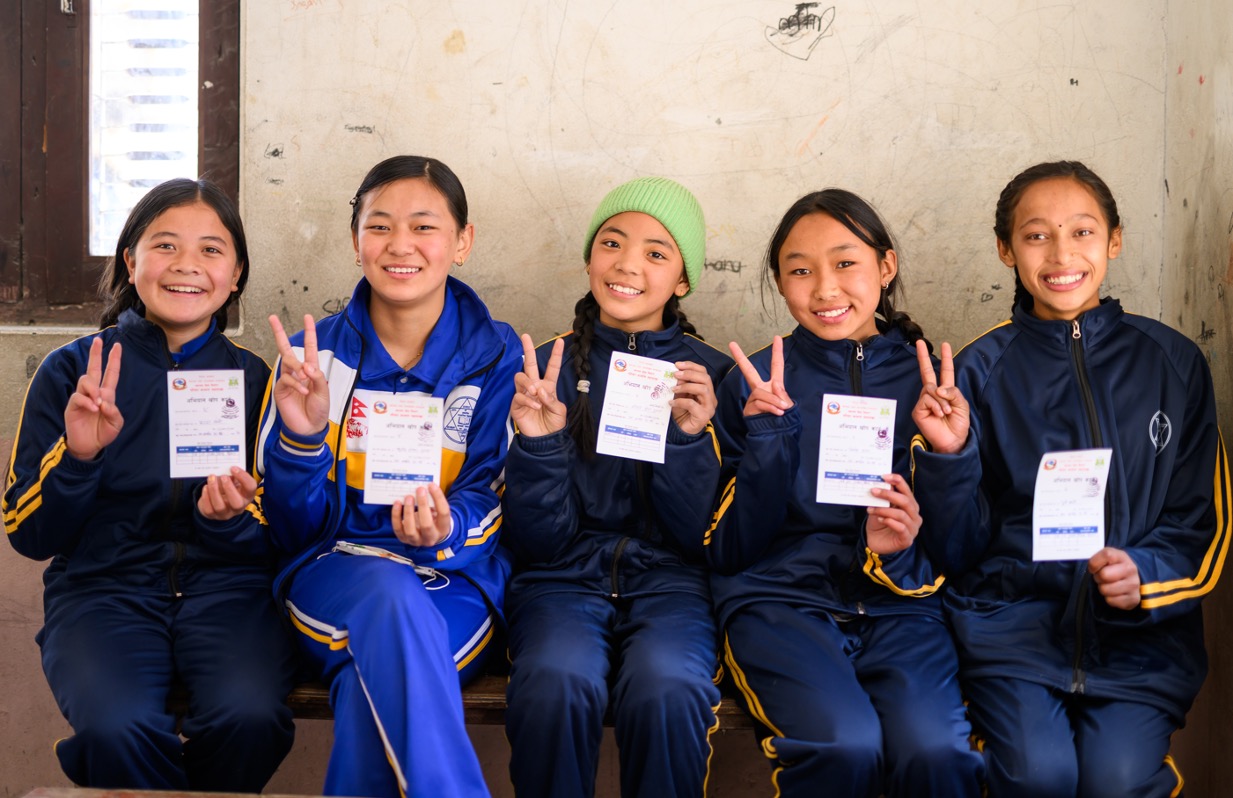Cervical cancer is the second most common cancer and the leading cause of cancer-related deaths among women in Nepal, with an estimated 4 women dying each day. Yet, these deaths are preventable. Human papillomavirus (HPV) vaccination is a proven, safe and effective intervention to protect women and girls.
To advance this life-saving effort, on World Cancer Day, 4 February 2025, Nepal took a monumental step toward cervical cancer elimination by launching a nationwide HPV vaccination campaign. This initiative aligns with Nepal’s commitment to the Global Strategy for the Elimination of Cervical Cancer, which aims to vaccinate 90% of girls by age 15.
Nepal’s journey began nearly a decade ago with an HPV demonstration project in Chitwan and Kaski districts. The experience provided valuable insights into effectively delivering vaccines to adolescent girls.

Girls showing their vaccination cards after receiving the HPV vaccine during a campaign in the Himalayan district of Mustang. Photo credit: ©WHO Nepal
Accelerating change using the Delivery for Impact (DFI) approach
In 2023, the WHO country office in Nepal became one of the early adopters of WHO’s Delivery for Impact approach, aimed at driving progress on priority health outcomes, including mobilizing action towards eliminating cervical cancer. The country team embarked on a Delivery Sprint, a time-bound, cohort-based initiative designed to accelerate measurable impact in health priority areas. Over 100 days, a multidisciplinary team within WHO Nepal, including experts in vaccination, noncommunicable diseases, health systems strengthening and planning – used the DFI approach to identify bottlenecks, set measurable targets and coordinate action. The impact cycle (Fig. 1) provided a clear framework to advance implementation.
/delivery-for-impact-(dfi)/figure-1.png?sfvrsn=ee7fd3a8_4)
Figure 1: Impact cycle; Source: Implementation playbook, deliverying impact for health (adapted from the ‘Evidence Ecosystem for Impact Framework’ in Evidence, policy, impact: WHO guide for evidence-informed decision-making (2021).
A comprehensive situational analysis and stakeholder engagement process led to the development of a robust Theory of Change, defining short- medium-, and long-term outcomes via identified solutions and WHO’s actions.
Dr Binod Prasad Gupta, the focal point for the delivery sprint, explained how the Theory of Change served as the foundation to translate ambition into action.
“The Theory of Change served as our strategic compass. It helped to bring national stakeholders together around a common goal and map the steps needed, from addressing vaccine hesitancy and ensuring supply chain readiness, from community trust-building to last-mile delivery – we turned a national plan into life-saving vaccinations for 1.4 million girls. By identifying key challenges and bottlenecks, it turned big ideas into real, coordinated action. That’s how the Delivery for Impact made a difference on the ground.”
Dr Binod Prasad Gupta, WCO Nepal Focal Point, Delivery for Impact, 100 days of the Delivery Sprint
| GOAL: Cervical Cancer Eliminated in Nepal | |||
|---|---|---|---|
| Inputs | Activities | Outputs/Results | Outcomes |
|
|
|
|
In the process, the team committed to vaccinating 90% of the target group within two years, aiming to reduce cervical cancer-related morbidity and mortality over time.
Achieving Remarkable Results
From 4 to 18 February 2025, the HPV vaccination campaign targeted 1.56 million schoolgirls from grades 6 to 10, and out-of-school girls aged 10 to 14 years. Within two weeks, more than 1.46 million girls were vaccinated, covering an impressive 94% of the target group, surpassing the initial two-year target of 90%. WHO continues to work with the Ministry of Health and Population (MoHP) to reach the remaining 6%.
"Vaccinating 1.4 million girls in just two weeks is a powerful testament to the Ministry of Health and Population’s leadership and commitment. This milestone reflects how the delivery action plan drives results through strong coordination and political will,"said Dr Balwinder Singh, Team Lead, Immunization Preventable Diseases (IPD) programme at WHO Nepal.
This achievement builds on years of collaboration between WHO, the MoHP and development partners. Since the 2016/2017 HPV demonstration programme, WHO has been a dependable partner – supporting advocacy, planning, implementation, monitoring, and partner coordination, including applying for Gavi funding to ensure the successful national rollout of HPV vaccines.
“WHO commends the Government of Nepal for this landmark achievement and remains committed to supporting sustained efforts in vaccination, screening, and treatment to eliminate cervical cancer.”
Dr Rajesh Sambhajirao Pandav, WHO Representative to Nepal.
Sustaining change
WHO will continue working with the Government of Nepal to foster a culture of impact by regularly monitoring progress, documenting lessons and making timely adjustments. These efforts aim to sustain momentum and achieve the long-term goal of eliminating cervical cancer in Nepal.
